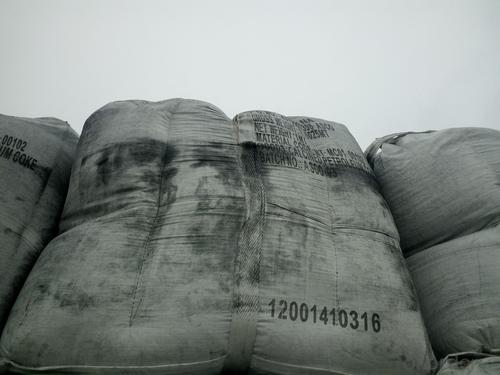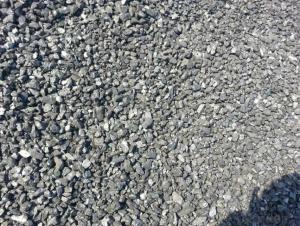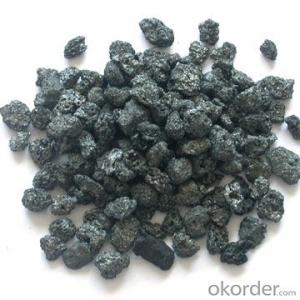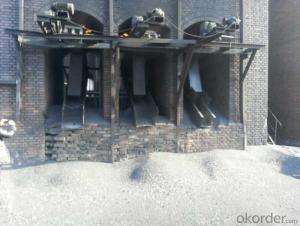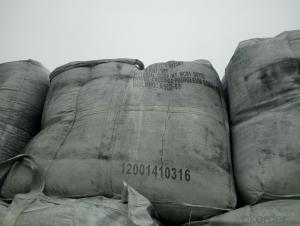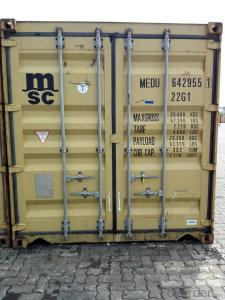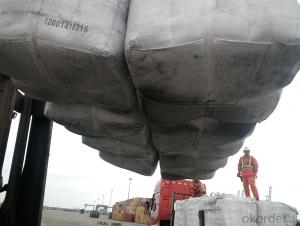Calcined Pitch Coke with Ash 0.5%max for Foudry Industry
- Loading Port:
- Tianjin
- Payment Terms:
- TT OR LC
- Min Order Qty:
- 21 m.t.
- Supply Capability:
- 8000 m.t./month
OKorder Service Pledge
OKorder Financial Service
You Might Also Like
Introduction
Pitch Coke/Coal Tar Pitch is a kind of black brittleness and blocky piece, lustrously at normal temperature. It has special odour and poisonous and can be easily flame when melting, second-grade inflammable solid.
Pitch Coke/Coal Tar Pitch is obtained from powerfully processed coal tar. Compared to petroleum asphalt, the adhesiveness is better. Coal Tar Pitch is high quality tar production with high fixed carbon. It has excellent adhesion, waterproofing and resistance against seawater, oil and various chemicals. In these properties, it is much better than petroleum asphalt tar.
It can be used to produce painting, electrode, pitch coke, and tar felt. It also can be used as fuel and the raw material of asphalt carbon black.
Features:
The morphology, chemistry and crystallinity of recarburisers have a major impact on the overall casting cost. The combined application and cost benefits, which are derived through the use of Desulco, enable foundries to manufacture castings in a highly cost effective manner.
reduces
Recarburiser consumption
Power consumption
Inoculant consumption
MgFeSi consumption
Furnace refractory wear
Scrap rate
Tap to tap time
Slag inclusions risk
Chill
increases
Casting microstructure
Productivity
Process consistency
Carbon Recovery
Compared with calcined petroleum coke, acetylene coke and
graphite electrode scrap, Desulco yields the highest carbon
recovery and fastest dissolution time
Specifications:
CPC | |||
F.C.% | 98.5MIN | 98.5MIN | 98MIN |
ASH % | 0.8MAX | 0.8MAX | 1MAX |
V.M.% | 0.7 MAX | 0.7 MAX | 1 MAX |
SULFUR % | 0. 5MAX | 0. 7MAX | 1MAX |
MOISTURE % | 0.5MAX | 0.5MAX | 1MAX |
Pictures:

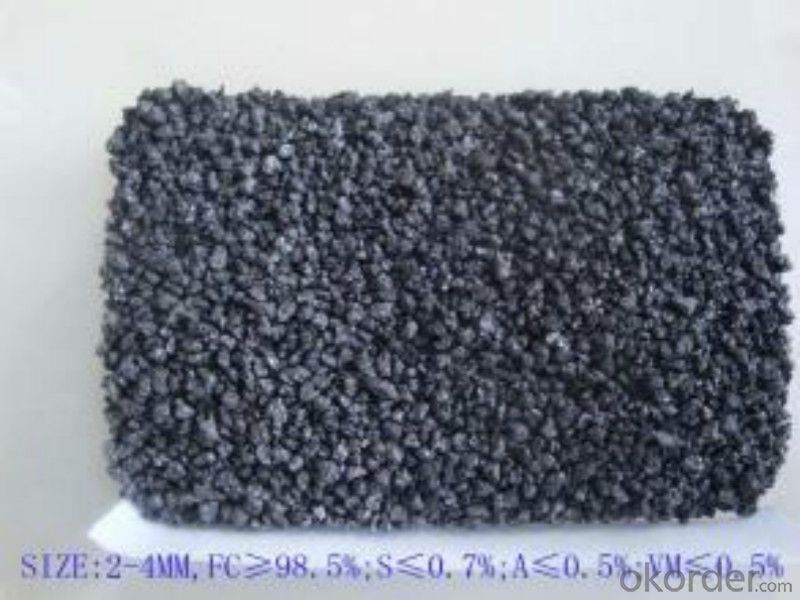

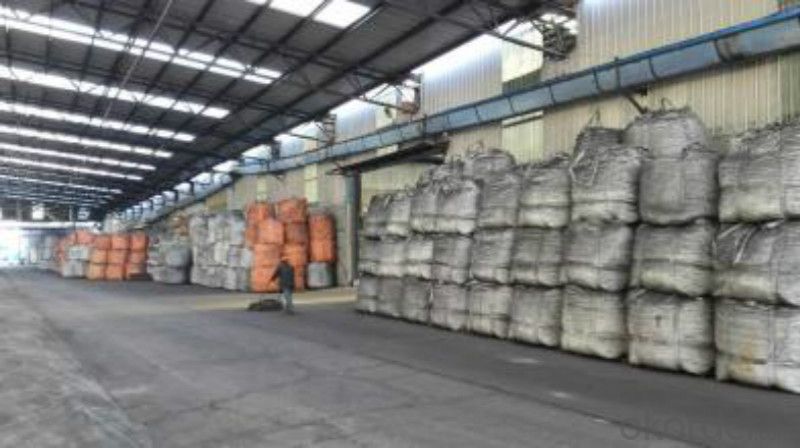
FAQ:
1.MOQ:2 Containers |
2.Size:1-3mm,1-5mm,2-6mm,3-5mm and as the customer's requirement |
3.Packing: 1 ton jumbo bag or 25kgs paper in bag |
4.Payment:T/T or L/C at sight |
5.Delivery time: within 15 days after receiving the deposit |
6.Usage: it is as carbon raiser,widely used in steelmaking,casting,casting iron,steel foundry,aluminum metallury. |
- Q: What are the properties of carbon fibers?
- Carbon fibers are known for their exceptional strength and stiffness, making them ideal for applications requiring high-performance materials. They possess a low density, corrosion resistance, and excellent thermal conductivity. Additionally, carbon fibers exhibit high resistance to fatigue and have a high tensile strength, allowing them to withstand extreme conditions. They are also chemically inert and have a low coefficient of thermal expansion, making them versatile for various industries such as aerospace, automotive, and sports equipment.
- Q: How does carbon affect the stability of ecosystems?
- Carbon plays a crucial role in the stability of ecosystems. It is a fundamental element that is essential for all living organisms. Carbon is present in the atmosphere, in the form of carbon dioxide (CO2), and is absorbed by plants during photosynthesis. This process allows plants to convert sunlight, water, and carbon dioxide into glucose, which is then used as energy for growth and development. The stability of ecosystems heavily relies on the balance of carbon in the environment. Carbon acts as a building block for organic matter and is stored in various forms such as plants, animals, soil, and the atmosphere. This storage of carbon helps to regulate the carbon cycle, which is crucial for maintaining a stable climate. One of the main ways carbon affects the stability of ecosystems is through its role in climate regulation. Carbon dioxide is a greenhouse gas, meaning it traps heat in the atmosphere and contributes to global warming. Excessive carbon emissions from human activities, such as burning fossil fuels, deforestation, and land-use changes, have led to an increase in carbon concentration in the atmosphere. This results in the enhanced greenhouse effect, leading to rising temperatures and climate change. Climate change has far-reaching consequences for ecosystems. It can disrupt the delicate balance of ecosystems by causing shifts in temperature and precipitation patterns, altering habitats, and affecting the timing of seasonal events. These changes can lead to the loss of biodiversity, as certain species may struggle to adapt to the new conditions. Additionally, climate change can also impact the availability of resources, such as water and food, which are essential for the functioning and stability of ecosystems. Furthermore, the excessive release of carbon into the atmosphere can also have direct negative effects on ecosystems. Acid rain, caused by high levels of carbon emissions, can lead to the acidification of water bodies, making them unsuitable for aquatic life. Increased carbon dioxide levels in the oceans can also lead to ocean acidification, which harms marine organisms like corals and shellfish. On the other hand, carbon is also essential for the health and productivity of ecosystems. Carbon-rich organic matter in the soil helps to retain nutrients, improve soil structure, and enhance water-holding capacity. This enables plants to grow better and supports the overall functioning of ecosystems. In conclusion, carbon has a profound impact on the stability of ecosystems. While it is necessary for the growth and development of living organisms, excessive carbon emissions and climate change pose significant threats to the balance and functioning of ecosystems. It is crucial to reduce carbon emissions, promote sustainable practices, and protect carbon sinks like forests and wetlands to ensure the long-term stability of ecosystems.
- Q: How do fossil fuels release carbon into the atmosphere?
- Combustion, a process in which fossil fuels like coal, oil, and natural gas are burned for energy, results in the release of carbon into the atmosphere. This carbon, which had been trapped underground for millions of years, is converted into carbon dioxide (CO2) gas. During combustion, the carbon and hydrogen atoms present in fossil fuels react with oxygen from the air, producing not only CO2 but also water vapor (H2O) and heat. The released CO2 is then emitted into the atmosphere, where it acts as a greenhouse gas. The burning of fossil fuels in various sectors such as transportation, electricity generation, and industrial processes plays a significant role in the escalating levels of atmospheric CO2. The continuous extraction and rapid burning of these fuels have led to a substantial increase in the concentration of CO2 in the Earth's atmosphere over the past century. This rise in atmospheric CO2 is a primary driver of climate change, as CO2 acts as a heat-trapping gas, contributing to the greenhouse effect. The greenhouse effect occurs when the Earth's atmosphere retains the heat radiated from the surface, resulting in a global temperature increase. Therefore, the release of carbon into the atmosphere from fossil fuels is a major concern due to its significant role in climate change and the subsequent environmental and societal impacts. To address these effects, there is a growing global effort to transition towards renewable and cleaner energy sources, reduce fossil fuel consumption, and implement sustainable practices.
- Q: How accurate is carbon dating?
- The scientific method known as carbon dating, or radiocarbon dating, is widely used to determine the age of organic materials that are up to 50,000 years old. It relies on measuring the ratio of radioactive carbon-14 (C-14) to stable carbon-12 (C-12) in a sample. Carbon dating has proven to be highly accurate, with a small margin of error. Its accuracy depends on factors such as the quality and preservation of the sample, the precision of measurement instruments, and understanding the carbon cycle in the past. However, carbon dating has limitations. It can only be used on organic materials that were once alive, so it is not applicable to dating inorganic materials like rocks or minerals. It is most effective for samples younger than 50,000 years old because the amount of C-14 decreases over time, making accurate measurement more challenging. To ensure accuracy, scientists often use multiple dating methods or cross-reference results with other independent techniques. This helps to verify the reliability of carbon dating and gain a more comprehensive understanding of the sample's age. Advancements in technology and calibration methods have improved the accuracy of carbon dating. For example, Accelerator Mass Spectrometry (AMS) allows for smaller sample sizes and greater measurement precision, reducing the margin of error. Calibration curves based on tree rings, or dendrochronology, also refine the accuracy of carbon dating. While carbon dating is highly reliable, it is important to recognize that no dating technique is perfect. All scientific dating methods have inherent limitations and uncertainties. However, with proper calibration and careful analysis, carbon dating remains one of the most accurate ways to determine the age of organic materials.
- Q: What is carbon footprint labeling?
- Carbon footprint labeling is a system that provides information about the carbon emissions associated with a product or service. It aims to educate consumers about the environmental impact of their purchases and enable them to make more sustainable choices. The labeling typically includes a measure of the greenhouse gas emissions produced during the entire life cycle of a product, including its production, transportation, and disposal. This allows consumers to compare the carbon footprints of different products and make informed decisions based on their environmental values. Carbon footprint labeling is an important tool in promoting sustainability and encouraging businesses to reduce their emissions. It also raises awareness about the impact of individual consumption choices on climate change and encourages a shift towards more environmentally friendly alternatives.
- Q: What are the different forms of carbon?
- Carbon exists in several different forms, known as allotropes. The most common forms of carbon include diamond, graphite, and amorphous carbon. Diamond is the hardest known natural substance and consists of carbon atoms arranged in a crystal lattice structure. It has a high refractive index and is often used in jewelry due to its brilliance and clarity. Graphite, on the other hand, has a layered structure where carbon atoms are arranged in sheets. It is a soft and slippery material, commonly used in pencils and lubricants. Graphite is also a good conductor of electricity, making it suitable for applications in batteries and electrodes. Amorphous carbon refers to a group of carbon materials that lack a well-defined crystal structure. Examples of amorphous carbon include charcoal, soot, and activated carbon. These forms of carbon have diverse applications, such as in water and air purification, as well as in the manufacturing of electrodes and pigments. Other forms of carbon exist as well, such as fullerenes and carbon nanotubes, which have unique properties and are extensively studied for their potential applications in various fields, including nanotechnology and electronics. In summary, carbon can take on different forms depending on its atomic arrangement, resulting in a range of materials with distinct physical and chemical properties. These forms of carbon find applications in various industries and are vital for our everyday lives.
- Q: What are the properties of carbon-based rubber?
- Carbon-based rubber, also known as carbon black-filled rubber, possesses several important properties that make it highly desirable for various applications. Firstly, carbon-based rubber exhibits excellent elasticity and flexibility, allowing it to withstand repeated stretching and compression without permanent deformation. This property makes it ideal for use in manufacturing products such as tires, gaskets, and seals. Secondly, carbon-based rubber displays outstanding resistance to abrasion and wear, ensuring that it can endure harsh conditions and prolonged use without deteriorating. This property is particularly beneficial in applications where the rubber material is subjected to friction or constant contact with rough surfaces. Additionally, carbon-based rubber demonstrates remarkable resistance to various environmental factors. It has excellent resistance to ozone, sunlight, and weathering, making it suitable for outdoor applications where it will be exposed to UV radiation and extreme temperatures. Its resistance to chemicals and oils further enhances its versatility, allowing it to be used in industries such as automotive, aerospace, and manufacturing. Another noteworthy property of carbon-based rubber is its electrical conductivity. This characteristic makes it an ideal material for applications that require static dissipation or protection against electrostatic discharge, such as in electronic devices, conveyor belts, and industrial flooring. Furthermore, carbon-based rubber exhibits good adhesion to various substrates, enabling it to form strong bonds when used in adhesive applications or as a lining material. Overall, the properties of carbon-based rubber make it a highly sought-after material due to its exceptional elasticity, abrasion resistance, environmental resistance, electrical conductivity, and adhesion capabilities.
- Q: What are the effects of carbon emissions on the stability of peatlands?
- Carbon emissions have significant effects on the stability of peatlands. Increased levels of carbon dioxide in the atmosphere contribute to global warming, which in turn accelerates the decomposition of organic matter in peatlands. This decomposition releases even more carbon dioxide, creating a positive feedback loop that further exacerbates climate change. Additionally, rising temperatures and changing precipitation patterns can lead to the drying out of peatlands, making them more prone to wildfires. These fires release massive amounts of carbon dioxide into the atmosphere, further contributing to climate change. Overall, carbon emissions threaten the stability of peatlands by accelerating their degradation and releasing large amounts of greenhouse gases.
- Q: What are the differences between the three carburizing, nitriding and carbonitriding? What are the different effects on the material?
- Carbonitriding is the method of treating the surface of steel parts at the same time, penetrating the carbon atoms, nitrogen atoms of the river, forming the carbonitriding layer, so as to improve the hardness and wear resistance of the workpiece and to improve the fatigue strength of the river
- Q: other parameters are figured out, the difference is only in the carbon and carbon is not very clear, just know that they are winding mode is the opposite, there are two kinds of most printers can be used, what is the difference between the performance of them? Two can use the printer in the selection of the best carbon or carbon? Why? Please cite several models as an example.Please answer in your own words. Don't factor,
- In fact, to teach you a simple way to distinguish between internal and external carbon, carbon, label paper dip ribbon, with black on the outside of the outer side is carbon, carbon is in inside, no performance difference, now generally used is the most carbon, such as the machine is to use carbon is better, because the wound is not the same, sometimes loose.SATO machine with carbon is better, and the CITIZEN printer inside and outside carbon can be used, in addition to machine limitations, not what the difference is too big, the quality of internal and external carbon ribbon is the same.
Send your message to us
Calcined Pitch Coke with Ash 0.5%max for Foudry Industry
- Loading Port:
- Tianjin
- Payment Terms:
- TT OR LC
- Min Order Qty:
- 21 m.t.
- Supply Capability:
- 8000 m.t./month
OKorder Service Pledge
OKorder Financial Service
Similar products
Hot products
Hot Searches


